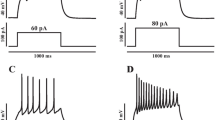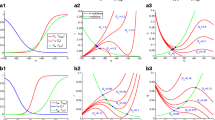Abstract
Studying neurons from an energy efficiency perspective has produced results in the research literature. This paper presents a method that enables computation of low energy input current stimuli that are able to drive a reduced Hodgkin–Huxley neuron model to approximate a prescribed time-varying reference membrane voltage. An optimal control technique is used to discover an input current that optimally minimizes a user selected balance between the square of the input stimulus current (input current ‘energy’) and the difference between the reference voltage and the membrane voltage (tracking error) over a stimulation period. Selecting reference signals to be membrane voltages produced by the neuron model in response to common types of input currents i(t) enables a comparison between i(t) and the determined optimal current stimulus i*(t). The intent is not to modify neuron dynamics, but through comparison of i(t) and i*(t) provide insight into neuron dynamics. Simulation results for four different bifurcation types demonstrate that this method consistently finds lower energy stimulus currents i*(t) that are able to approximate membrane voltages as produced by higher energy input currents i(t) in this neuron model.
Similar content being viewed by others
References
Atwell D, Laughlin SB (2001) An energy budget for signaling in the grey matter of the brain. J Cereb Blood Flow Metab 21(10): 1133–1145
Chavarette FR, Balthazar JM, Rafikov M, Hermini HA (2009a) On non-linear dynamics and an optimal control synthesis of the action potential of membranes (ideal and non-ideal cases) of the Hodgkin-Huxley (HH) mathematical model. Chaos Solitons Fractals 39: 1651–1666
Chavarette FR, Balthazar JM, Peruzzi NJ, Rafikov M (2009b) On non-linear dynamics and control designs applied to the ideal and non-ideal variants of the Fitzhugh-Nagumo (FN) mathematical model. Commun Nonlinear Sci Numer Simul 14: 892–905
Danzl P, Hespanha J, Moehlis J (2009) Event-based minimum-time control of oscillatory neuron models: phase randomization, maximal spike rate increase, and desynchronization. Biol Cybern 101: 387–399
Danzl P, Nabi A, Moehlis J (2010) Charge-balanced spike timing control for phase models of spiking neurons. Discrete Continuous Dyn Syst 28: 1413–1435
Feng J, Tuckwell HC (2003) Optimal control of neuronal activity. Phys Rev Lett 91: 018101
Harmon K (2009) Earlier model of human brain’s energy usage underestimated its efficiency. Scientific American, September 2009. Available at scientificamerican.com
Izhikevich EM (2007) Dynamical Systems in neuroscience: the geometry of excitability and bursting. The MIT Press, Cambridge, MA
Lewis FL, Syrmos VL (1995) Optimal control, 2 edn. Wiley, Inc., New York
Moehlis J, Shea-Brown E, Rabitz H (2006) Optimal inputs for phase models of spiking neurons. J Comput Nonlinear Dyn 1: 358–367
Mohan DK, Molnar P, Hickman JJ (2006) Toxin detection based on action potential shape analysis using a realistic mathematical model of differentiated NG108-15 cells. Biosens Bioelectron 21: 1804–1811
Niven JE, Laughlin SB (2008) Energy limitation as a selective pressure on the evolution of sensory systems. J Exp Biol 211: 1792–1804
Rieke F, Warland D, de Ruyter van Steveninck R, Bialek W (1999) Spikes: exploring the neural code. The MIT Press, Cambridge, MA
Schiff SJ, Sauer T (2008) Kalman filter control of a model of spatiotemporal cortical dynamics. J Neural Eng 5: 1–8
Sengupta B, Stemmler M, Laughlin SB, Niven JE (2010) Action potential energy efficiency varies among neuron types in vertebrates and invertebrates. PLoS Comput Biol 6: e1000840
Shampine LF, Kierzenka J, Reichelt MW (2010) Solving boundary value problems for ordinary differential equations in MATLAB with bvp4c. http://www.mathworks.com/support/solutions/attachment.html?resid=1-9SOW1I&solution=1-15S5M, October 8
Stigen T, Danzl P, Moehlis J, Netoff T (2009) Linear control of neuronal spike timing using phase response curves. In: 31st Annual international conference of the IEEE EMBS, (Minneapolis), pp 1541–1544, September 2–6
Tass PA (1999) Phase resetting in medicine and biology. Springer Verlag, New York
Tass PA (2000) Effective desynchronization by means of double-pulse phase resetting. Europhys Lett 53(1): 15–21
Ullah G, Schiff SJ (2009) Tracking and control of neuronal Hodgkin-Huxley dynamics. Phys Rev E 79: 040901
Author information
Authors and Affiliations
Corresponding author
Rights and permissions
About this article
Cite this article
Ellinger, M., Koelling, M.E., Miller, D.A. et al. Exploring optimal current stimuli that provide membrane voltage tracking in a neuron model. Biol Cybern 104, 185–195 (2011). https://doi.org/10.1007/s00422-011-0427-9
Received:
Accepted:
Published:
Issue Date:
DOI: https://doi.org/10.1007/s00422-011-0427-9




